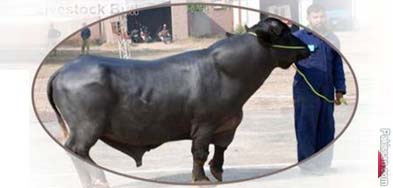|
Upgrading dairy technology
By Tauseef Khan Babar
 June
13, 2011: OUTDATED dairy farming practices have undermined
growth potential of this sector, which exceeds the combined
value of two major crops — wheat and cotton. June
13, 2011: OUTDATED dairy farming practices have undermined
growth potential of this sector, which exceeds the combined
value of two major crops — wheat and cotton.
It is time to formulate a proactive strategy to promote
modern farming for boosting quality milk production.
Growers prefer integrated farming. They think it is
beneficial for them because the farm residue is utilised in
dairy farms and the waste of dairy outfits is used for
growing crops. This minimizes their production cost.
But in the absence of modern dairy management techniques,
its profitability relative to other forms of farming has
been overshadowed.
Pakistan possesses a huge animal population of 50-60 million
which is three times larger than that of Germany but
unfortunately, the yields are one fifth due to low
productivity of our animals, as a result of imbalanced
feeding, unhygienic care and lack of drinking water.
About 70 per cent of dairy farmers are smallholders. Various
reports indicate that 40-45 per cent of dairying households
maintain herd sizes of one to two animals while 25-30 per
cent have three to four animals. However, 90 per cent of
milk production comes from small farmers.
Researchers believe that it is only large mechanised farms
that can ensure increased profitability and quality just
like developed countries.
In Pakistan, a dual purpose strategy has to be evolved both
for the development of small and large-scale commercial
farms which provide profitability for the small farmers and
also maintain quality through the supply chain.
In China, the large dairy farms are usually owned by dairy
processors and highly mechanised outfits that utilise modern
techniques of milk production. However, these farms do not
account for the bulk of milk production and the smallholding
production co-exists.
Small farmers in China either take their cows to the milking
locations or the cows are housed near the milking facility —
to allow cows managed by households to be milked by machine
and the milk goes directly to a refrigerated bulk tank.
In New Zealand and Australia, they have evolved a system of
local area entrepreneurs (generally known as “contractors”)
who own grass cutting and hay baling equipment, and bring
these items to individual farms at agreed times and for
agreed rates.
The contractors do not rent the equipment, rather they
provide full service, including using the equipment on the
farm. In this way, the cost of a large asset is spread over
many farms, bringing mechanisation to a large number of
farmers which would be impossible otherwise.
The optimum production of dairy animals can only be achieved
if we ensure regular provision of quality feed and fodder
even during slump periods but unfortunately only 14 per cent
of the total cropped area of Pakistan is allocated to fodder
crops.
Dairy farmers generally cultivate oats and berseem as “Rabi
fodders” while maize, sorghum and millet as “Kharif
fodders”.
Berseem is rich in protein but low in energy, while all
other fodders are deficient in proteins but are a good
source of energy. The provision of concentrate feed
formulation should complement the nutrient availability from
the fodder. Nutrient availability also depends upon the
stage of growth of the fodder.
The provision of minerals is essential for the efficient
productive and reproductive performance of dairy animals
which could only be done either by offering mineral mixture
daily in the concentrate ratio or by placing mineral blocks
in mangers for the animals to lick at their will.
Generally there are two fodder scarcity periods
(December-January and May-June) for fodder, leading to
decrease in milk production. The dairy farmers during the
scarcity periods feed the animals wheat straw but
unfortunately the use of mechanical harvesters for wheat
harvesting deprives them from it. Furthermore, millions of
tons of wheat straw are also being exported to neighbouring
countries, pushing up its prices and depriving animals of
balanced diet.
Unfortunately, the Directorate of Livestock Farms Punjab set
up in 1962 has not been able to provide quality breed
animals at subsidised rate to the farmers on tenancy basis (
provided that the farmers will cultivate fodder in
proportionate to given number of animals).
Milk, being a highly perishable commodity, does not give
many choices to dairy farmers for storage and the
unorganised middlemen are considered a speedy substitute for
a cold supply chain.
It is imperative to keep dairy animals healthy to increase
quality milk production and it is only possible through
training of the farmers about vaccination, dipping,
de-worming and mastitis control programme (milk screening
test, milk let down techniques, milking methods and teat
dipping).
Courtesy: The DAWN
|
Pakissan.com;
|